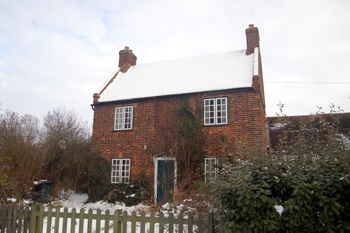319 The Green Cardington

319 The Green Christmas Eve 2010
319 The Green was listed by the former MInistry of Public Buildings and Works in July 1964 as Grade II, of special interest. The ministry dated the property to 1784 thanks to the survey below. It is built of red brick and has an old clay tiled roof. A single storey outhouse built of red brick with a clay tiled roof stands at the rear.
We are fortunate that three surveys of the parish of Cardington from the late 18th century survive. The first of these was undertaken in 1782 by James Lilburne. He was the parish schoolmaster and later agent for Samuel Whitbread, who owned large estates in the parish and also the sole Enclosure Commissioner for the parish. He produced a list of all the inhabitants of the parish arranged by house and hamlet [P38/28/1]. This was published, with extensive analysis by County Archaeologist David Baker in 1973 as Bedfordshire Historical Record Society Volume 52.
Since publication a second list has been found [P38/28/2]. It carries revisions up to the year 1789. Sadly neither of these surveys includes a map. Finally, in 1794 Lilburne produced another survey [W2/6/1-3] and this one had a map with a key showing where each house was. One can use this to plot the houses of the previous surveys and this work was carried out by John Wood of Bedfordshire County Council’s Conservation Section in October 1982 [CRT130Cardington29].
The 1782 survey [P38/28/1/2] stated that a cottage stood here which was occupied by William Trueman, malt maker. The entry states: “This house was Pulled down, and a new Public house [now the King's Arms] built in 1783, and Bigrave’s Cottage in 1784”. The 1794 survey [W2/6/1-3] states that the occupier of the cottage adjoining the public house was was Richard Bigrave.
The Rating and Valuation Act 1925 specified that every building and piece of land in the country was to be assessed to determine its rateable value. Cardington, like most of the county, was assessed in 1927 and the valuer visiting 319 The Green [DV1/C116/22] found it owned by the Whitbread Estate and in the occupation of J. G. Huckle who paid rent of £2/11/10 for the half year. His accommodation comprised a parlour, a living room and a washhouse with three bedrooms (“one very, very small”) upstairs. The valuer commented: “only one fireplace up”.